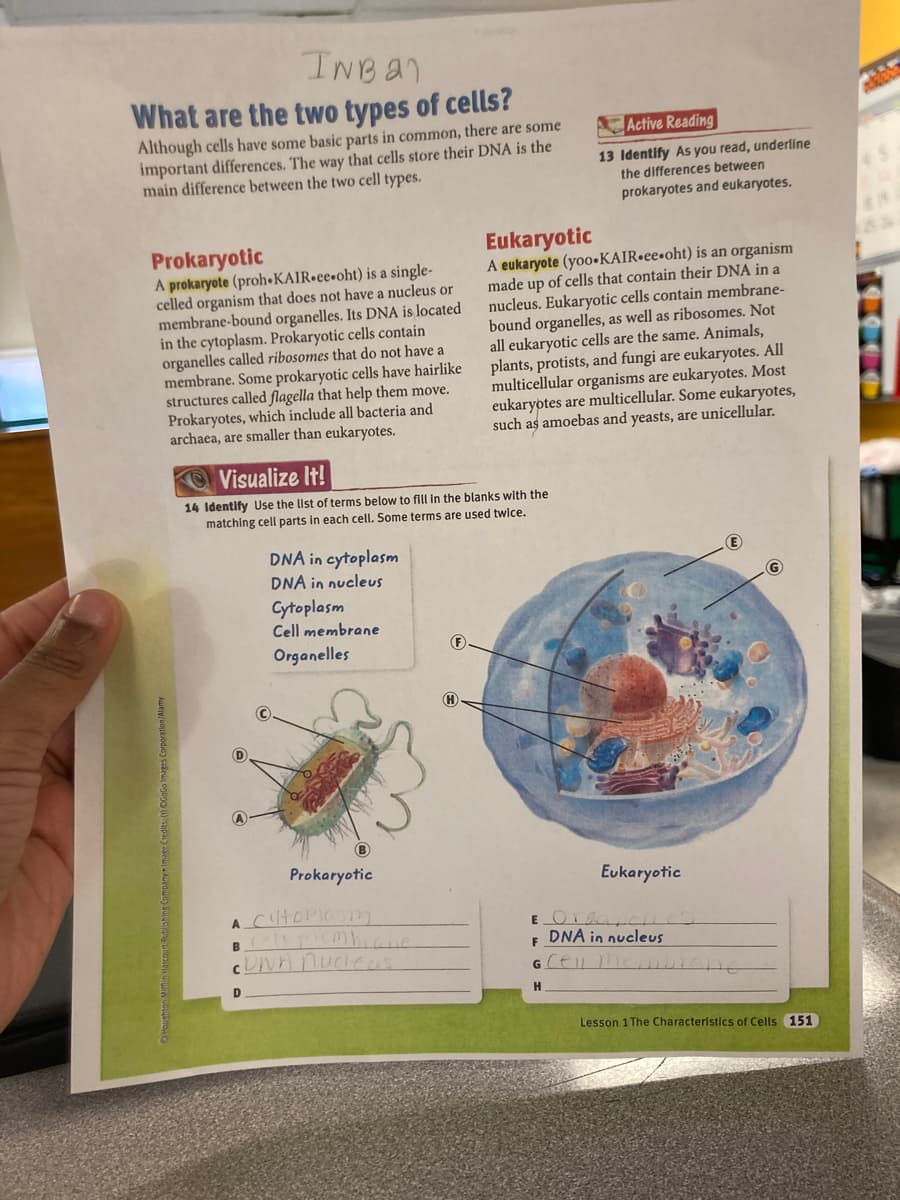What are the two types of cells? Although cells have some basic parts in common, there are some important differences. The way that cells store their DNA is the main difference between the two cell types. Prokaryotic A prokaryote (proh-KAIR-ee-oht) is a single- ue a nucleus or Active Reading 13 Identify As you read, unde the differences between prokaryotes and eukaryotes Eukaryotic A eukaryote (yoo-KAIR-ee-oht) is an organis made up of cells that contain their DNA in a tain membrane
What are the two types of cells? Although cells have some basic parts in common, there are some important differences. The way that cells store their DNA is the main difference between the two cell types. Prokaryotic A prokaryote (proh-KAIR-ee-oht) is a single- ue a nucleus or Active Reading 13 Identify As you read, unde the differences between prokaryotes and eukaryotes Eukaryotic A eukaryote (yoo-KAIR-ee-oht) is an organis made up of cells that contain their DNA in a tain membrane
Human Anatomy & Physiology (11th Edition)
11th Edition
ISBN:9780134580999
Author:Elaine N. Marieb, Katja N. Hoehn
Publisher:Elaine N. Marieb, Katja N. Hoehn
Chapter1: The Human Body: An Orientation
Section: Chapter Questions
Problem 1RQ: The correct sequence of levels forming the structural hierarchy is A. (a) organ, organ system,...
Related questions
Question

Transcribed Image Text:INBan
What are the two types of cells?
Although cells have some basic parts in common, there are some
important differences. The way that cells store their DNA is the
main difference between the two cell types.
Prokaryotic
A prokaryote (proh-KAIR-ee.oht) is a single-
celled organism that does not have a nucleus or
membrane-bound organelles. Its DNA is located
in the cytoplasm. Prokaryotic cells contain
organelles called ribosomes that do not have a
membrane. Some prokaryotic cells have hairlike
structures called flagella that help them move.
Prokaryotes, which include all bacteria and
archaea, are smaller than eukaryotes.
Visualize It!
14 Identify Use the list of terms below to fill in the blanks with the
matching cell parts in each cell. Some terms are used twice.
DNA in cytoplasm
DNA in nucleus
Cytoplasm
Cell membrane
Organelles
D
C
Prokaryotic
A CHOPlasm
CUNA nucleas
F
H
Eukaryotic
A eukaryote (yoo.KAIR.ee oht) is an organism
made up of cells that contain their DNA in a
nucleus. Eukaryotic cells contain membrane-
bound organelles, as well as ribosomes. Not
all eukaryotic cells are the same. Animals,
plants, protists, and fungi are eukaryotes. All
multicellular organisms are eukaryotes. Most
eukaryotes are multicellular. Some eukaryotes,
such as amoebas and yeasts, are unicellular.
Active Reading
13 Identify As you read, underline
the differences between
prokaryotes and eukaryotes.
H
Eukaryotic
E Organche
F DNA in nucleus
G
Lesson 1 The Characteristics of Cells 151
aitaba
Expert Solution
This question has been solved!
Explore an expertly crafted, step-by-step solution for a thorough understanding of key concepts.
Step by step
Solved in 3 steps

Recommended textbooks for you

Human Anatomy & Physiology (11th Edition)
Anatomy and Physiology
ISBN:
9780134580999
Author:
Elaine N. Marieb, Katja N. Hoehn
Publisher:
PEARSON

Anatomy & Physiology
Anatomy and Physiology
ISBN:
9781259398629
Author:
McKinley, Michael P., O'loughlin, Valerie Dean, Bidle, Theresa Stouter
Publisher:
Mcgraw Hill Education,

Human Anatomy
Anatomy and Physiology
ISBN:
9780135168059
Author:
Marieb, Elaine Nicpon, Brady, Patricia, Mallatt, Jon
Publisher:
Pearson Education, Inc.,

Human Anatomy & Physiology (11th Edition)
Anatomy and Physiology
ISBN:
9780134580999
Author:
Elaine N. Marieb, Katja N. Hoehn
Publisher:
PEARSON

Anatomy & Physiology
Anatomy and Physiology
ISBN:
9781259398629
Author:
McKinley, Michael P., O'loughlin, Valerie Dean, Bidle, Theresa Stouter
Publisher:
Mcgraw Hill Education,

Human Anatomy
Anatomy and Physiology
ISBN:
9780135168059
Author:
Marieb, Elaine Nicpon, Brady, Patricia, Mallatt, Jon
Publisher:
Pearson Education, Inc.,

Anatomy & Physiology: An Integrative Approach
Anatomy and Physiology
ISBN:
9780078024283
Author:
Michael McKinley Dr., Valerie O'Loughlin, Theresa Bidle
Publisher:
McGraw-Hill Education

Human Anatomy & Physiology (Marieb, Human Anatomy…
Anatomy and Physiology
ISBN:
9780321927040
Author:
Elaine N. Marieb, Katja Hoehn
Publisher:
PEARSON